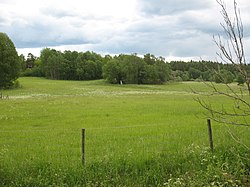
The Lingsberg Runestones are two 11th-century runestones,[1] listed as U 240 and U 241 in the Rundata catalog, and one fragment, U 242, that are engraved in Old Norse using the younger futhark. They are at the Lingsberg farm[2] about 2 kilometres (1.2 mi) east of Vallentuna (halfway to Kusta), which is about 24 kilometres (15 mi) north of the center of Stockholm, Stockholm County, Sweden, which was part of the former province of Uppland.
The two intact runestones were raised by members of the same family, and on U 241 they engraved for posterity that a grandfather had taken two Danegelds in England. Because the receipt of the Danegeld (tax) indicates likely service with the Scandinavian troops in the Thingmen from 1018 to 1066, the runestones are dated to the second quarter of the 11th century.[3]
- ^
- "Lindsberg". Vallentuna Kommun.
- Otto von Friesen. "Historiska runinskrifter. 3. Lingsbergastenarna, Vallentuna socken, Uppland" (PDF). Samla.
- ^ "Riksintressen K77" (PDF). Vallentuna Kommun.
- ^ Fuglesang, Signe Horn (1998). "Swedish Runestones of the Eleventh Century: Ornament and Dating". In Düwel, Klaus; Nowak, Sean (eds.). Runeninschriften als Quellen Interdisziplinärer Forschung. Berlin: Walter de Gruyter GmbH. pp. 201–202. ISBN 3-11-015455-2.